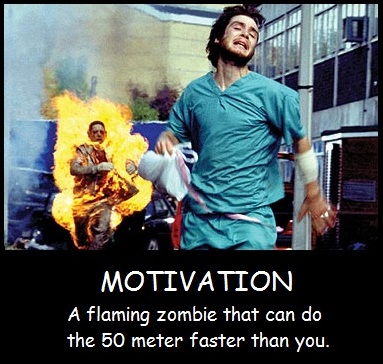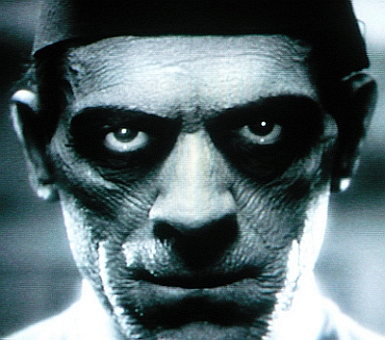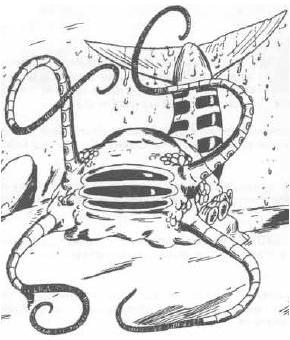 My son Giant Boy and I watched 28 Days Later a few nights ago. This film often gets lumped in the zombie genre, but it’s not really a zombie movie (but it is survival horror, which includes zombie pics). The infected in 28DL aren’t zombies. They’re people driven into a seemingly permanent psychotic frenzy by some sort of biological experiment accidentally released from an animal testing facility at Cambridge.
My son Giant Boy and I watched 28 Days Later a few nights ago. This film often gets lumped in the zombie genre, but it’s not really a zombie movie (but it is survival horror, which includes zombie pics). The infected in 28DL aren’t zombies. They’re people driven into a seemingly permanent psychotic frenzy by some sort of biological experiment accidentally released from an animal testing facility at Cambridge.
The day after we watched 28DL, Giant Boy said, “Patermaximus, might we write some sort of zombie horror apocalypse adventure?”
I said, “I dunno. I guess.”
And so here we are, with me writing this and you reading it.
The first question Giant Boy insisted we answer was what game system to use. The Pathfinder Roleplaying Game doesn’t seem a good fit. Fireball-lobbing wizards, vital-striking fighters, and disease-curing clerics don’t look they’d work well in the survival horror genre. Giant Boy suggested Mutants & Masterminds, but that is a math-intensive game when it comes to scenario design. Other suggestions included True 20 (which I have in unprinted PDF format but little experience with) and Savage Worlds (which I have only the short, free test drive PDF). Obviously, there are other systems specifically written for horror games. There’s even a zombie horror RPG, All Flesh Must Be Eaten (which I own none of and don’t feel like purchasing).
Watching me poo poo one game system after another, Giant Boy said, “Patermaximus, which system shall we use if we use none of those?”
Good question. One thing I enjoy is taking a game system and making it do things it wasn’t necessarily designed to do. I also like blending genres, which my players in Man Day Adventures will soon discover. (Muahaha!) As I pondered Giant Boy’s question, I thought these thoughts:
“The system needs to be something simple. Rules lite seems better than rules heavy for this sort of game.”
“The system needs to be something I already have a copy of.”
“The system needs to be something decidedly not intended for survival horror.”
One RPG kept pressing itself to the forefront of my brain each time I asked these questions. Yes, that’s right. Beyond Belief Games’ Go Fer Yer Gun!. What could be cooler than a blending of 28DL with cowboys and Indians? (Yes, yes, I know about Deadlands, but I’m not going for the weird west).
With that decision out of the way, it was time to brainstorm about my zombies. Foremost, I don’t want slow-moving, brain-eating undead. I mean, I love George Romero as much as any red-blooded American boy, but Romeroid zombies just seem so typical nowadays. 28DL was intense because its zombies aren’t zombies, and they’re fast and relentless. I mean, really fast. Those raging maniacs could windsprint like nobody’s business even after they were set on fire. On top of their speed and relentlessness, 28DL “zombies” didn’t have to bite you to infect you. They could projectile vomit blood at you instead. They could splatter on you when someone hacks them with a machete. They were a bloodborne pathogens worst-case scenario on steroids. As Frank (the most affecting and best acted character in 28DL as portrayed by Brendan Gleeson) demonstrated, even a single drop of blood from one of the infected after death could turn a loving father into a frothing-at-the-mouth killer in a matter of seconds.
Now that’s scary.
So, now I had the beginnings of a “zombie” checklist:
1. They’re not really zombies. They’re infected by a super-virus.
2. They’re jacked up on adrenaline and homicidally psychotic.
After this, my mind wandered toward other source material. You know how zombies eat brains? Do you know why zombies eat brains? It was explained in The Return of the Living Dead. Zombies eat brains because they’re in constant pain from decomposition, and brains act as a sort of anesthetic. I also recalled the two of Guillermo del Toro and Chuck Hogan’s novels in their Strain Trilogy (which reminds me that I still haven’t read the third installment). Those books are about vampires, but not Bela Lugosi vampires. Instead, Strain vampires are infected with a bizarre parasite that transforms the host’s entire physiology in grotesque, horrifying ways.
Two more things for the checklist:
3. Motivation for cannibalism.
4. Physical changes caused by virus.
That looked like a good start, and so I took Giant Boy’s ubiquitous pad of drawing paper away from him while we waited for Mrs. Chance to get done at work. I jotted down some notes about traits of the infected:
Trait 1: The host’s lymph nodes swell into buboes. These buboes fill with a mixture of blood, pus, and live virus. Not only can they pop if roughly handled, the virus changes the host’s body so that the host can vent its buboes’ contents via the mouth and nose.
Trait 2: The infected do not respirate the way humans do. Their lungs do not serve any particular purpose. More physiological changes, however, give an infected the ability to voluntarily control its thoracic diaphragm. By contracting or relaxing this muscle, an infected can inhale or exhale, permitting it produce limited vocalizations. The infected cannot speak, except perhaps single syllable words that would be more hissed than articulated, but they can growl, moan, et cetera.
Trait 3: Further physiological changes alter bone structure and density. The proximal and distal phalanges fuse (N.B. limited finger dexterity), and the fused bones grows into something very much like a spike. Since the bones are denser as a whole, the infected is more durable and less suspectible to injury.
Trait 4: The infected’s brain changes as well. It enters a hyper-adrenaline state which constantly floods the infected’s body with this powerful hormone. At the same time, the nervous system is less sensitive to pain and fatigue.
Trait 5: The infected kill and eat the non-infected because uninfected human tissues contain a variety of hormones which nourish the virus. Chief among the hormones that the infected crave are arenaline and cortisol, the hormones that trigger the flight-or-fight response.
As Giant Boy read this over my shoulder (which I find annoying but tolerate because I’m so loveable), I could hear him shuddering. I think this first draft of “zombie” traits is a good start for an Old West survival horror scenario.
Next post, I’ll turn the spotlight onto the player characters. Since this looks like the sort of setting that lends itself to high levels of PC death, I need to implement some sort of “survival of the fittest” considerations that keeps the threat of death very real for characters but also makes it easy to keep the players involved in the game after their heroes get eaten.
Tags: 28 Days Later, adventure design, horror, undead


 My
My  My son Giant Boy and I watched
My son Giant Boy and I watched 